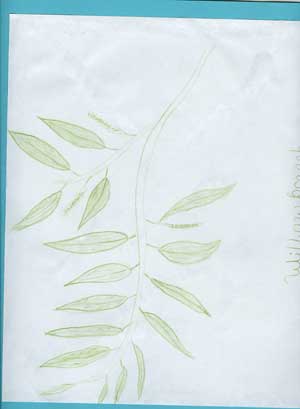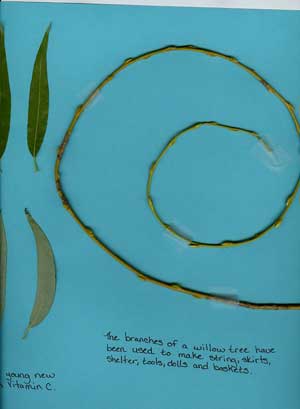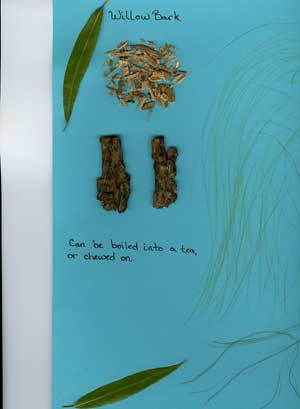
 Willow
Willow
Family Name: Salicaceae
Family Name: Willow
Latin Name: Salix spp.
Common Names: Willow, White Willow, European Willow, Black Willow, Pussy Willow, Crack Willow, Purple Willow, Weeping Willow, Liu-zhi.
Native American Names: wahpé-popa-can (Lakota), thihe (Omaha) and ruhi (Winnebago). http://www.northern.edu/natsource/TREESA1/Willow1.htm
Related Species: Peachleaf Willow (S. Amygdaloides), Laurel Willow (S. pentandra) http://www.ag.ndsu.nodak.edu/aginfo/trees/handbook/th‑3‑145.pdf
Body System Affiliations:

1. Nervous System
Botanical Description:
Habit: Tree, shrub
Size: to 45' in height
Leaves: long, thin, shiny. Length/width ratio 5-6/1, narrow, short stems
Arrangement: Alternate
Shape- Simple
Surface- Smooth on top, silky beneath
Length- 1½ to 4inches
Width- 1/4 to 5/8 inches
Color- Green
http://www.wsdot.wa.gov/environment/culres/ethbot/q‑s/Salix.htm
Flowers Type: Catkin
Flower Color: Light green to yellowish
Fruit Type: Cottony or silky hairy seeds
Fruit Color: Greenish-yellow
Bark: Flat, scaly
Twigs: Typically thin and brown and might droop as the tree grows.
Underground Parts: Roots are aggressive and can spread up to three times the distance
from the trunk and will often grow above ground.
Ecology: http://plants.usda.gov/plantguide/pdf/cs_salul.pdf
Habitat: This species prefers damp heavy soil, sun and low elevations. And can be found near riverbanks, floodplains, lakeshores, and wet meadows.
Range:
Native Where: Pacific Willow is native along stream banks from British Columbia southward to southern California and New Mexico.
Ecological Relationships: This species is useful for bank stabilization, re-vegetation and erosion control.The early spring flowers are a source of nectar and new leaves are desirable to grazing animals.
Places/Dates Observed/Description: I have observed and admired Willow trees
throughout my life. As a young child I can remember being amazed by their shape,
elegance and beauty. I’ve recently taken notice to a handful of Weeping Willows located
in Thurston County. Two of which are located on the Evergreen State College campus,
one in downtown Olympia and one near the Nisqually Basin.
Harvest: Willow bark can be harvested all year around.
Plant Part: Bark and leaves.
Season of Harvest: It is best to harvest Willow leaves early in the Spring.
Method of Harvest: Willow bark can be peeled from the trunk of the tree or shaved from a branch.
Indigenous and Non-Western Use/Significance/Relationships:
The ancient Chinese, Hippocrates, Greek physicians, Romans and Native Americans have been known to use Willow bark as a pain reliever, fever reducer and digestive aid. Native Americans also have used twigs to make baskets, skirts, dolls, string and shelter.
Western (European-American) Uses/Relationships:
Edible Uses: Can be dried and ground into a powder which then can be added to cereal flour used for making bread.Raw or dry bark can be made into tea.
Materials/Technology: Basketry, string, charcoal, wood and paper.
Body System Associations: Nervous System
Constituents: Salicylic acid
Harvest: When grown for basket making this plant is harvested annually, or if thickers branches are needed you can harvest every two years.
Storage: Should be kept in a dry place. Moisture can cause mold and other erosion.
Applications: Dried herb (used to make tea): boil 1 to 2 tsp of dried bark in 8 oz of water and simmer for 10 to 15 minutes; let steep for ½ hour; drink 3 to 4 cups daily
Powdered herb: 1 to 3 g daily
Tincture (1:5, 30% alcohol): 4 to 6 mL three times per day
Pharmacy: Relieves joint pain, headaches and can reduce fevers. Use as: anti-inflammatory, antiperiodic, antiseptic, astringent.
Cautions:
- Should not be taken with aspirin.
- Avoid if you are sensitive to aspirin, have an ulcer, or some other gastrointestinal disorder.
- Don’t tale willow bark if you have tinnitus.
- Never give children willow bark if they show cold or flu symptoms.
Personal Experience: 
Edible Uses: Tea
Medicine:
Part Used: Bark
Medicinal Actions: Pain relief
Indications: Headache
Body System Associations: Nervous System
Constituents: Salicylic acid
Harvest:
Site Location: I was lucky enough to explore my friend’s 5 acre organic Farm in Olympia. There I locate several Willow trees!
Site Description: There were three Willow trees located in close proximity of one another near a seasonal stream. The ground was covered in damp grass and I could see and feel part of a root system that was slightly above ground. The air was cool and crisp and clouds gloomed up above. The leaves had already begun to change colors and fall to the ground.
Technique: I knelt beside the tree, taking in it’s magnificent beauty. I touched the bark and admired it’s color. I then used my hand to free a few pieces of bark.
Processing: I kept the bark in a basket for several days to dry. (However, it is not necessary to dry the bark before making into tea.
Applications: Tea
Preparation: I peeled apart the pieces of bark and steeped in hot water for
10-15 minutes.
Pharmacy: Drink 3 to 4 times daily
Reason/Purpose: I intend to use this as a relief for headaches.
Experience: The first taste seemed a little strange, almost bitter. However, as I continued to drink the tea it was soothing and delightful in taste.
Other Notes of Interest:
The genus name Salix comes from the Celtic word "sal lis", meaning "near water"
Sources:
http://www.northern.edu/natsource/TREESA1/Willow1.htm
http://plants.usda.gov/plantguide/pdf/cs_salul.pdf
http://www.dnr.wa.gov/htdocs/lm/field_guides/recognizing/trees.html
http://www.wsdot.wa.gov/environment/culres/ethbot/q‑s/Salix.htm
Child Friendly Version |
 |
 |
||
 |
 |
||
 |
 |